BASIC AND ADVANCE SPELLING RULES
1. Basic Spelling Rules
“When two vowels go walking, the first one does the talking.” Words that appear on screen include: boat, meat, train, pail, rain, brain, soap, say, neat, beat, dream, pain, and plain.

Magic E rule – marking long vowels: The silent “e” at the end of a word often signals that the preceding vowel is a long vowel sound, rather than a short vowel sound. For example:
- “hope” (long “o” sound) vs. “hop” (short “o” sound)
- “cube” (long “u” sound) vs. “cub” (short “u” sound)
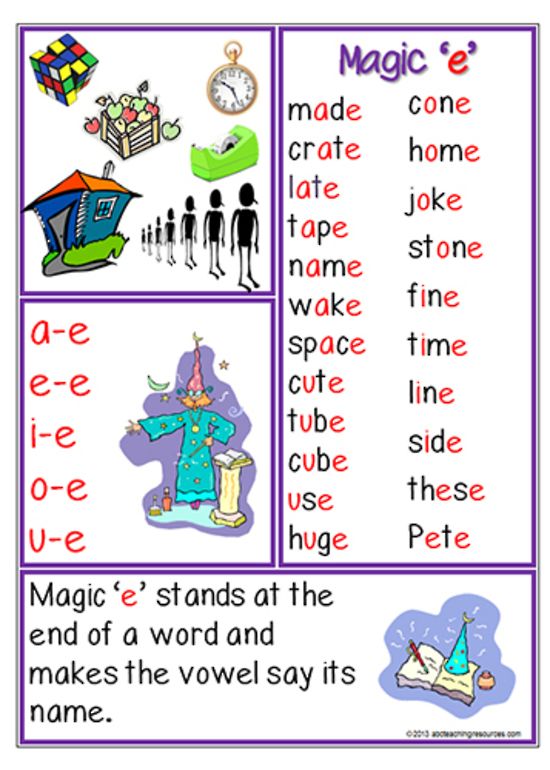
Cat Kite Rule
If the vowel in the middle of the word is “a,” “o,” or “u,” use “C.”
If the vowel in the middle of the word is “i” or “e,” use “K.”
Milk Truck Rule
To spell the sound of /k/ at the end of a word, we use ck or k.
Use ck after a short vowel (sick).
After everything else, use a k (milk).
Use c at the end of a word with 2 syllables or more
Use ke after a long vowel with magic e

Soft C and Soft G rule Making consonants soft: The silent “e” can make a preceding consonant soft or “say its name.” For example:“nice” (soft “c” sound) vs. “nic” (hard “c” sound)
Changing the pronunciation of “g”: The silent “e” after “g” can make “g” soft, changing its pronunciation. (soft “g” sound) For example:”rage” (soft “g” sound) vs. “rag” (hard “g” sound)

Bossy R Rule
When a syllable has a vowel that is followed by r, the vowel is “controlled” by the r and makes a new sound. Examples include car, bird, germ, form, and hurt. This rule is sometimes called “bossy r” because the r “bosses” the vowel to make a new sound.
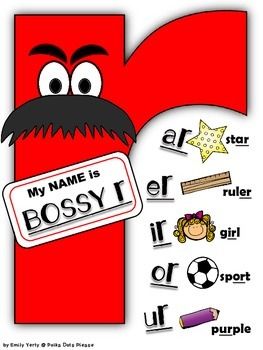
Doubling consonants: When a word has a short vowel sound followed by a single consonant, the consonant is often doubled before adding a suffix that begins with a vowel. For example: “swim” becomes “swimming,” “run” becomes “running,” “big” becomes “bigger.”
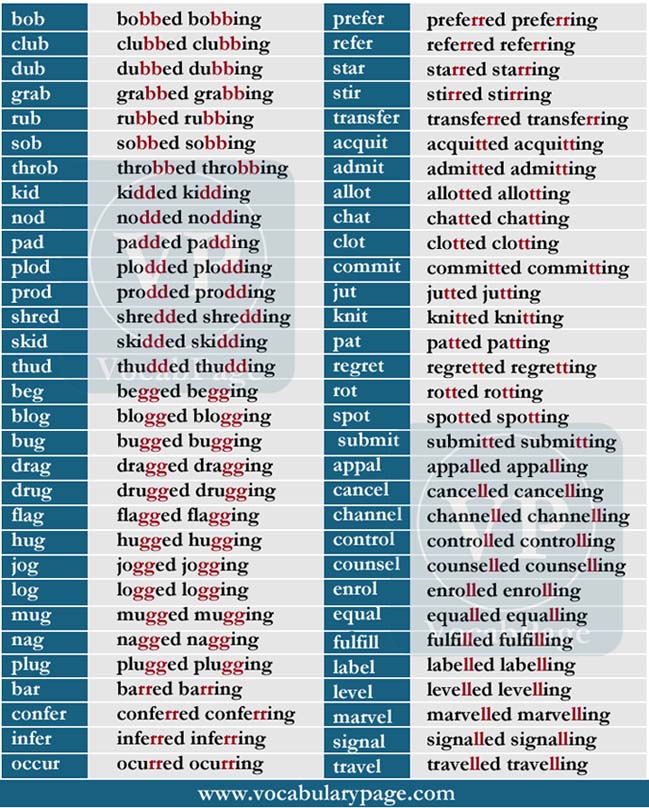
Shy I Toughy Y
‘Shy i, toughy y’ as in words with an ai or oi sound at the end the i is too shy so it changes to a y. For example day or toy. The rule extends to the ee sound which usually becomes either y or ey.
“y” as a vowel: “y” can function as a vowel in some words, typically at the end of a word or syllable, and can represent the sound of a long “i” or a long “e.” For example: “sky,” “cry,” “baby,” “happy,” “funny.”
“y” as a consonant: “y” is usually considered a consonant when it appears at the beginning of a word or syllable, or when it is followed by a vowel. For example: “yes,” “yellow,” “yarn,” “yoga.”
Changing “y” to “i” before a suffix: When a word ends in “y” and is followed by a suffix that begins with a vowel, the “y” is usually changed to “i.” For example: “try” becomes “trying,” “baby” becomes “babies,” “carry” becomes “carried.”


Floss Rule
If a word ends in a short vowel sound (e.g., “a,” “e,” “i,” “o,” “u”) followed by the letters “f,” “l,” or “s,” and the consonant is preceded by a single vowel, then double the consonant in the spelling of the word.
Examples of words that follow the “Floss Rule”:
- “staff”
- “spell”
- “miss”
- “grass”
- “puff”
- “fill”
- “kiss”
- “buzz”
- “off”

The ‘Rabbit Rule’ is a commonly taught spelling rule that addresses the double consonant in words like ‘rabbit’ and ‘kitten’. The ‘Rabbit rule’ says that if a word has two syllables, the vowel is short and there is only one consonant sound placed between the vowels, then the consonant in the middle is doubled.

2. Advance Spelling Rules
Rule no. 1
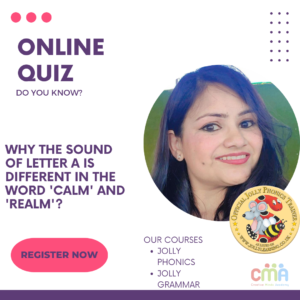
Why the sound of letter <A> is different in the words palm and realm?
Spelling rules make it little easy for children to learn spellings.
The letter “a” in English can represent a variety of different sounds. Here are 10 different sounds that “a” can make in English:
- Short “a” sound: as in “cat,” “hat,” “man”
- Long “a” sound: as in “cake,” “take,” “name”
- Schwa sound: as in “sofa,” “banana,” “camera”
- Broad “a” sound: as in “father,” “bath,” “laugh”
- R-controlled “a” sound: as in “car,” “bar,” “hard”
- Nasal “a” sound: as in “man,” “pan,” “can”
- Diphthong “ay” sound: as in “day,” “play,” “say”
- Silent “a” sound: as in “bread,” “heard,” “debt”
- Soft “a” sound: as in “angel,” “cage,” “gable”
- “aw” sound: as in “law,” “saw,” “paw”
The specific sound that “a” makes in a word can be influenced by factors such as the word’s origin, the surrounding letters, and the pronunciation of the speaker.
The words having <alm> like calm, palm, balm have <aa> sound where as the word realm has <e> sound. It is because in palm, p is consonant which is followed by alm. In the word realm, a letter forms a vowel team with letter e – <ea>.
The word “realm” has a different sound compared to the word “palm” because they have different vowel sounds. In “realm,” the vowel sound is an “e” sound, which is pronounced with the mouth slightly more closed and the tongue higher in the mouth compared to the “aa” sound in “palm.”
The difference in the vowel sound is due to the word’s history and origin in the English language. “Realm” comes from the Middle English word “realme,” which was pronounced with an “e” sound. Over time, the pronunciation of the word has remained relatively consistent, and it is still pronounced with the “e” sound today.
In contrast, the word “palm” comes from the Old English word “palma,” which was pronounced with “aa” sound.
English words can have different pronunciations due to various factors, such as their origin, history, and changes in pronunciation over time.
Rule no. 2- When does (ch) gives <k> and <sh> sound?
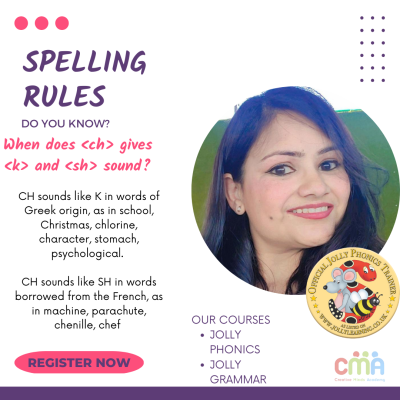
The reason why “ch” can represent both the “k” sound and the “sh” sound is because it depends on the language or dialect in which it is used. In some languages, such as German, “ch” represents a voiceless velar fricative /x/, which sounds similar to a “k” sound but is produced in the back of the throat. In other languages, such as French and English, “ch” represents a voiceless palato-alveolar affricate /t͡ʃ/, which sounds like a combination of “t” and “sh” sounds.
In addition to different languages, “ch” can also have different pronunciations within a language depending on the word and its origin. For example, in French, the word “chef” is pronounced with a “k” sound, while the word “champagne” is pronounced with a “sh” sound.
It’s also worth noting that the pronunciation of “ch” has changed over time in certain languages. For example, in Old English, “ch” was pronounced as a guttural “h” sound, but later evolved into the “ch” sound we know today.
- English: In English, “ch” can be pronounced as either the “ch” in “chair” or the “ch” in “church”.
-
Spanish: In Spanish, “ch” is pronounced as the “ch” in “chico” or “mucho”.
-
German: In German, “ch” can be pronounced in a variety of ways, depending on the word and the dialect. For example, it can be pronounced as the “ch” in “ich” (meaning “I”) or the “ch” in “nicht” (meaning “not”).
-
French: In French, “ch” is usually pronounced as the “sh” in “sheep” or “shell”. However, there are some words where it is pronounced as the “k” sound, such as “chef” (pronounced “kef”).
-
Mandarin Chinese: In Mandarin Chinese, “ch” is pronounced as the “ch” in “church”.
-
-
Modern Greek: In Modern Greek, “ch” is pronounced as the “ch” sound in German, which is a voiceless velar fricative. For example, the Greek word “χαρά” (chara), meaning “joy”, is pronounced with the “ch” sound like in the word “loch”.
-
Ancient Greek: In Ancient Greek, the letter “χ” represented a voiceless velar fricative as well, and is sometimes transliterated into English as “ch”. For example, the Greek word “χάρις” (charis), meaning “grace”, would be transliterated into English as “charis”.
-
Rule no. 3- When does <c> gives <sh> sound?
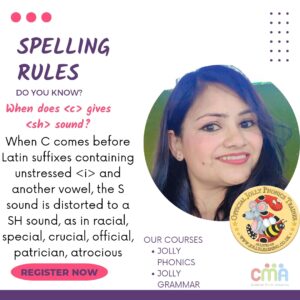
https://www.facebook.com/creativemindsacademy.inThe letter combination “cial” in English can also sometimes represent the “sh” sound, particularly in words of Italian origin.
For example, the word “special” is pronounced with a “sh” sound, as in “spesh-uhl”. This is because the word has been borrowed from Italian, where “sc” followed by a vowel is pronounced as “sh”. Similarly, the word “artificial” is pronounced with a “sh” sound, as in “ar-tuh-fish-uhl”, because it is also derived from Italian.
It’s worth noting that this pronunciation of “cial” as “sh” is not the only possible pronunciation. In other words, “cial” can also be pronounced with a hard “c” sound, as in the word “official”. The pronunciation of “cial” depends on the origin of the word and the language from which it has been borrowed.
Rule No. 4- Why the sound of letter A is different in the word <car> and <carry>?

Why does the sound of letter A is different in the word car and cart?
When the short sound is changed by final R, or by R followed by a different consonant sound, as in car, cart, car-ton, car-nation
But if the next sound is a vowel, it will capture the R sound, and leave the A unchanged, as in car-ry, bar-rel, pa-ra-graph, da-ring
Rule no. 5- Why bl is split in the word "problem"?
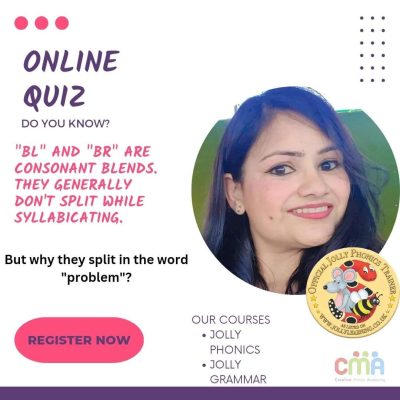
https://www.instagram.com/jollyphonicstrainer/The reason why we split the letters “bl” in the word “problem” is because of a spelling convention in English called the “VC/CV” pattern. In this pattern, when a word has two consonants between two vowels, the word is split between the consonants to form two syllables, with the first syllable containing the first vowel and the first consonant, and the second syllable containing the second vowel and the second consonant.
In the case of “problem”, there are two consonants “bl” between the two vowels “o” and “e”. Therefore, we split the word between the “b” and “l” to form two syllables, “prob-” and “-lem”. This conforms to the VC/CV pattern.
It’s worth noting that there are some exceptions to the VC/CV pattern in English, and there are some words where the consonants between two vowels do not get split into separate syllables. However, this pattern is a common rule that can be helpful in understanding how to divide longer words into syllables.
Defender D and G - Rule no. 6 and 7
When you have a short vowel followed by ch sound, defender t comes in to protect the short vowel sound. This is why, we hear the short vowel sound even on adding a vowel beginning suffix like in the words catchy. Exceptions are mentioned.
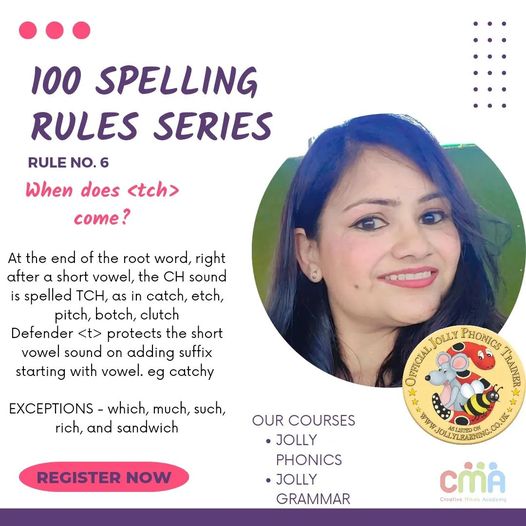

Digraph <ch> <sh> - Rule no. 8 and 9

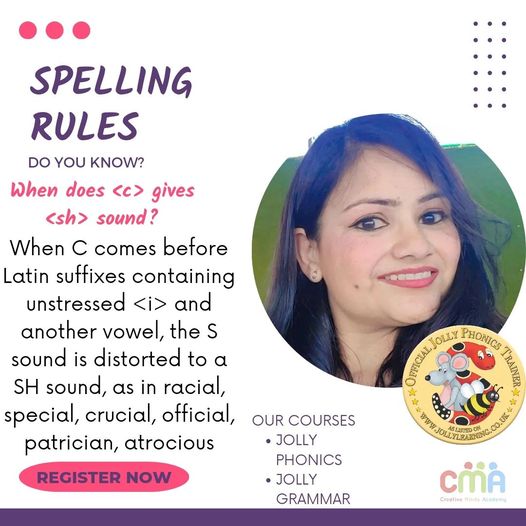
Rule no. 10 - When does E makes long vowel sound?
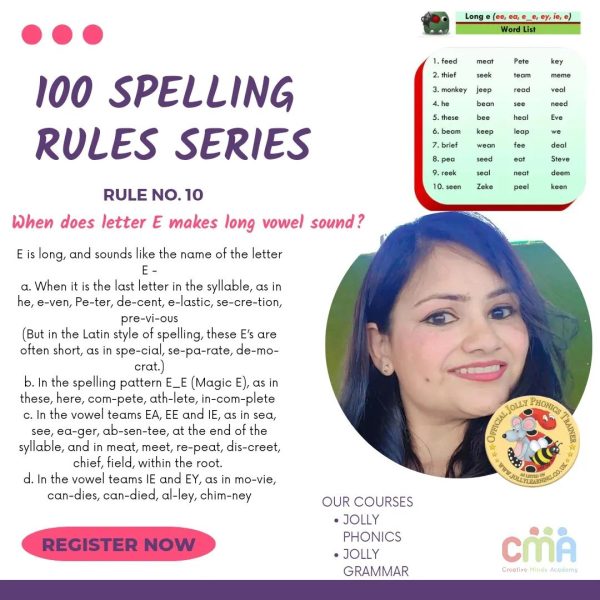
E is long, and sounds like the name of the letter E –
a. When it is the last letter in the syllable, as in he, e-ven, Pe-ter, de-cent, e-lastic, se-cre-tion, pre-vi-ous
(But in the Latin style of spelling, these E’s are often short, as in spe-cial, se-pa-rate, de-mo-crat.)
b. In the spelling pattern E_E (Magic E), as in these, here, com-pete, ath-lete, in-com-plete
c. In the vowel teams EA, EE and IE, as in sea, see, ea-ger, ab-sen-tee, at the end of the syllable, and in meat, meet, re-peat, dis-creet, chief, field, within the root.
d. In the vowel teams IE and EY, as in mo-vie, can-dies, can-died, al-ley, chim-ney
Rule No. 11 - Many jobs of silent "E"

E is silent when it is the very last letter in a word which also contains another vowel letter. Final silent E has the following functions:
a. After a single vowel letter followed by a single consonant letter, silent E makes the previous vowel long, as intape, these
b. Silent E adds length to a very short word, making it look important enough to be a main-idea word, as in tie, ore
c. After a single S which has another consonant or a vowel team before it, silent E shows that the S belongs to the root, as in dense, false, purse, house, pause, praise Here the E shows that the S is not a suffix, as it is in dens, falls
d. After a single Z which has another consonant or a vowel team before it, silent E shows that the Z belongs to the root, as in bronze, gauze, freeze This does not seem very necessary, but whatever S does, Z does, too.
e. After a V, silent E keeps the V from being the last letter in the word, as in have, be-have, carve, elves, leave, grieve. No language which employs the letter V permits it to be final in the word. Unfortunately, this leaves English with no satisfactory way to spell the short vowels in have, live and give, or in the many words ending in the suffix -ive, such as na-tive.
f. After C or G, silent E makes the C or G soft, as in face, chance, force, page, change, badge, large, hinge
Many words ending in silent E can take suffixes beginning with consonants. In such words, the E remains silent, as in statement, basement, toeless, densely, amazement, forgiveness, forceful, largely
Many words ending in silent E can take suffixes beginning with vowels. Then, the E must be dropped before the suffix is added, as in baker, tied, denser, freezing, giving, forcible, largest, basal But the E is not dropped if the vowel of the suffix would harden a soft C or G, as in noticeable, chargeable
Rule No. 12- different pronunciation of <ed>
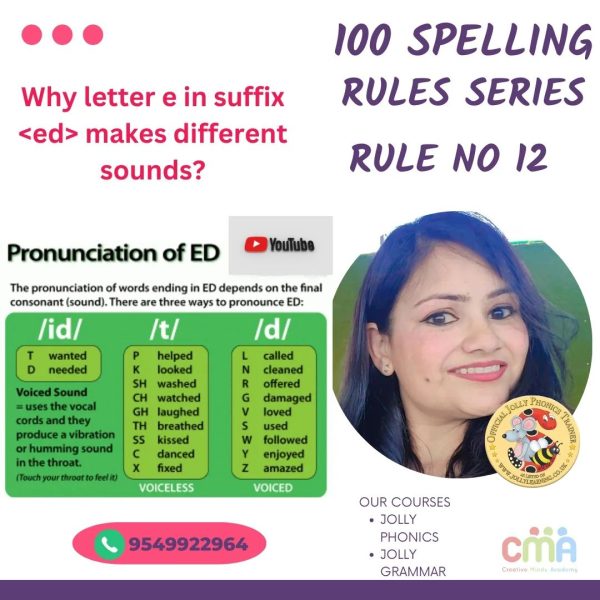
When does -ed is pronounced as d, t and id?
We pronounce the –ed as /d/ after voiced consonants, except /d/. For example rained, failed, and robbed.
We pronounce the –ed as /t/ after unvoiced consonants, except /t/. For example cooked, helped, watched.
We pronounce the –ed as /id/ after /d/ and /t/. For example started, decided, and visited.
Rule no. 13 - I before E, Except after C

Do you know?
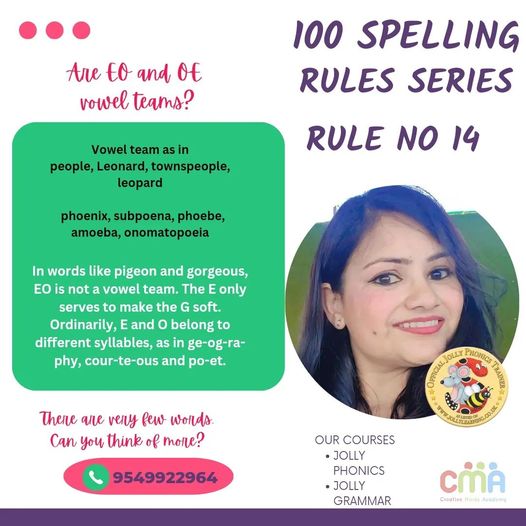

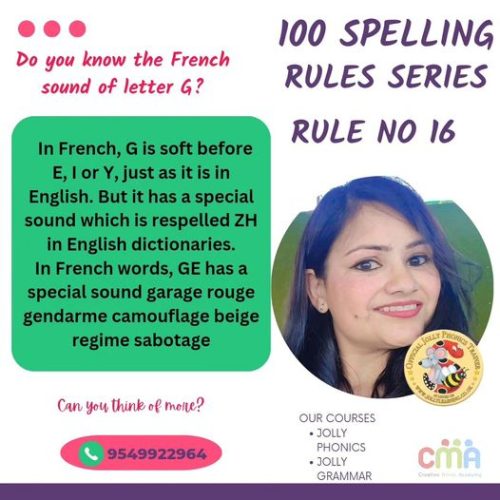
Digraphs with letter H - Spelling Rules Jolly Phonics - Rule No. 17
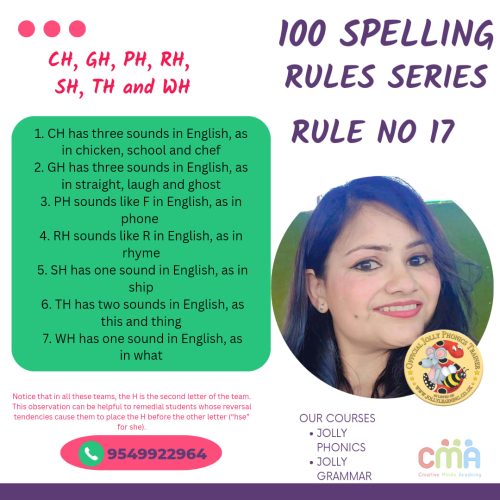
Digraphs having letter H
1. CH has three sounds in English, as in chicken, school and chef
2. GH has three sounds in English, as in straight, laugh and ghost
3. PH sounds like F in English, as in phone
4. RH sounds like R in English, as in rhyme
5. SH has one sound in English, as in ship
6. TH has two sounds in English, as
this and thing
7. WH has one sound in English, as in what
Notice that in all these teams, the H is the second letter of the team. This observation can be helpful to remedial students whose reversal tendencies cause them to place the H before the other letter (“hse” for she).
Rule no. 18 OLD WILD RULE

Spelling rule series!
You must be knowing
In the letter groups -IND, -ILD and -IGN, when they are at the end of the root, as in find, kind, wild, child, sign, align
But what you might not know is in longer forms of these words, the I often goes short, as in kin-dred, wil-der-ness, chil-dren, sig-nal, ma-lig-nant
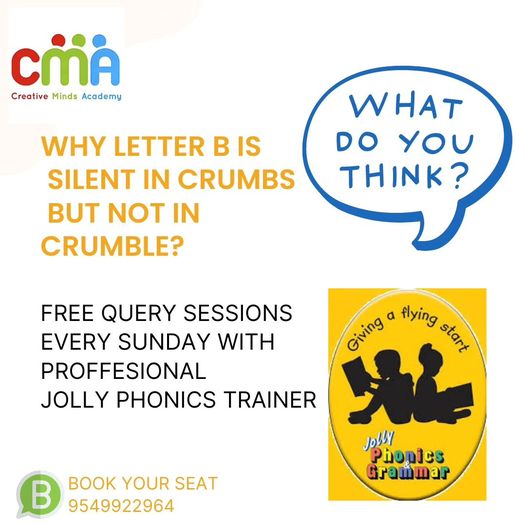
Rule No. 19
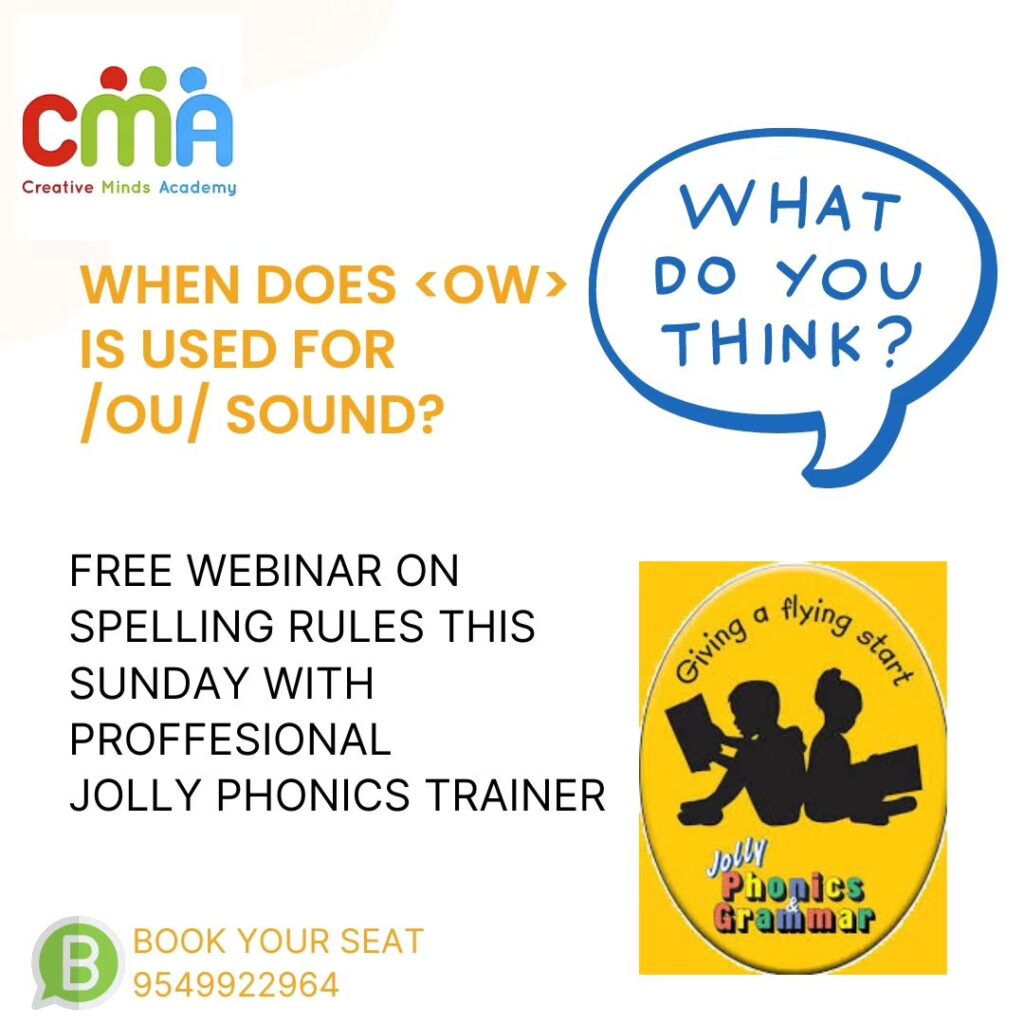
Rule No. 20
OW spells this sound at the end of the syllable, before final L and N, and sometimes before final D, as in cow, prow, tow-er, tow-el, cow-ard, al-low, howl, down, brown, crowd, pow-der
100 spelling rules
- When a word has a short vowel sound, it is usually spelled with one vowel letter followed by one or more consonant letters (cat, dog, sit).
- When a word has a long vowel sound, it is usually spelled with a vowel letter followed by a silent “e” (cake, kite, bone).
- When two vowels are side by side in a word, the first vowel is usually long and the second vowel is silent (boat, rain, team).
- The letter “y” at the end of a word can represent the long “i” sound (fly, sky, dry).
- The letter “y” at the beginning of a word or in the middle of a word usually represents the consonant sound /y/ (yellow, yes, beyond).
- When a word ends in a consonant followed by “y,” the “y” is usually changed to “i” before adding a suffix (happy -> happiness, baby -> babies).
- When a word ends in a vowel followed by “y,” the “y” usually remains unchanged when adding a suffix (play -> playing, toy -> toys).
- When a word ends in “le,” the “e” is usually silent and the preceding consonant usually forms a separate syllable (able, table, bottle).
- Words ending in “ck” usually have a short vowel sound before the “ck” (back, neck, pick).
- Words ending in “tch” usually have a short vowel sound before the “tch” (itch, match, watch).
- When two consonants are side by side in a word, they are usually blended together (stop, flag, print).
- When “c” comes before “e,” “i,” or “y,” it usually represents the soft “s” sound (city, circle, celery).
- When “g” comes before “e,” “i,” or “y,” it usually represents the soft “j” sound (giant, giraffe, gym).
- When “ph” appears in a word, it usually represents the “f” sound (phone, alphabet, dolphin).
- When “kn” appears in a word, the “k” is usually silent (knee, knife, knock).
- When “wr” appears in a word, the “w” is usually silent (write, wrinkle, wrong).
- When “gh” appears in a word, it can represent various sounds, such as /f/ in enough, /g/ in ghost, or silent in sight.
- Words ending in “-tion” usually have the /shun/ sound (nation, station, action).
- Words ending in “-ture” usually have the /chur/ sound (adventure, picture, feature).
- Words ending in “-ture” or “-sure” usually have the /zhur/ sound (measure, pleasure, treasure).
- When “ch” appears in a word, it can represent various sounds, such as /ch/ in chair, /k/ in school, or /sh/ in chef.
- When “dge” appears in a word, it usually represents the /j/ sound (badge, edge, fudge).
- When “t” comes before “ion” in a word, it is usually pronounced as /shun/ (nation, station, action).
- When “s” or “c” comes before “e,” “i,” or “y,” it usually represents the soft “s” sound (cent, city, cell)
- When “ph” appears in a word, it can represent the /v/ sound (phone, pharmacy, elephant)
- When “s” or “c” comes before “a,” “o,” or “u,” it usually represents the hard “s” sound (gas, cost, bus).
- When “s” or “c” comes before “k,” it usually represents the /sk/ sound (ask, desk, risk).
- When “a” comes before “u,” it usually represents the /aw/ sound (autumn, launch, haul).
- When “ou” appears in a word, it usually represents the /ow/ sound (cloud, house, shout).
- When “ow” appears in a word, it can represent various sounds, such as /ow/ in cow, /oh/ in show, or /oo/ in snow.
- When “oi” appears in a word, it usually represents the /oy/ sound (coin, join, boil).
- When “oy” appears in a word, it usually represents the /oi/ sound (toy, royal, annoy).
- When “ear” appears in a word, it usually represents the /eer/ sound (ear, fear, clear).
- When “eer” appears in a word, it usually represents the /ear/ sound (cheer, deer, peer).
- When “igh” appears in a word, it usually represents the /igh/ sound (high, sight, might).
- When “ew” appears in a word, it usually represents the /oo/ sound (new, few, chew).
- When “ue” appears in a word, it usually represents the /oo/ sound (blue, clue, true).
- When “au” appears in a word, it usually represents the /aw/ sound (autumn, author, sauce).
- When “aw” appears in a word, it usually represents the /aw/ sound (saw, raw, draw).
- When “ph” appears in a word, it usually represents the /f/ sound (phone, alphabet, dolphin).
- When “dge” appears in a word, it usually represents the /j/ sound (badge, edge, fudge).
- When “wr” appears in a word, the “w” is usually silent (write, wrinkle, wrong).
- When “kn” appears in a word, the “k” is usually silent (knee, knife, knock).
- When “gh” appears in a word, it can represent various sounds, such as /f/ in enough, /g/ in ghost, or silent in sight.
- When “qu” appears in a word, it usually represents the /kw/ sound (queen, quick, quilt).
- When “tion” appears in a word, it usually represents the /shun/ sound (nation, station, action).
- When “ture” appears in a word, it usually represents the /chur/ sound (adventure, picture, feature).
- When “sure” appears in a word, it usually represents the /zhur/ sound (measure, pleasure, treasure).
- When “gh” appears at the beginning of a word, it usually represents the /f/ sound (ghetto, ghost, gherkin).
- When “oe” appears in a word, it usually represents the /oh/ sound (toe, foe, hoe).
- When “ey” appears in a word, it usually represents the /ee/ sound (key, monkey, valley).
- When “ei” appears in a word, it can represent various sounds, such as /ee/ in receive, /ay/ in eight, or /ey/ in heir.
- When “eigh” appears in a word, it usually represents the /ay/ sound (eight, weight, neighbor).
- When “ea” appears in a word, it can represent various sounds, such as /ee/ in bead, /e/ in bread, or /ea/ in break.
- When “ai” appears in a word, it usually represents the /ay/ sound (rain, pain, gain).
- When “ay” appears in a word, it usually represents the /ay/ sound (say, day, play).
- When “au” appears in a word, it usually represents the /aw/ sound (haul, launch, August).
- When “ou” appears in a word, it can represent various sounds, such as /ow/ in soup, /oo/ in group, or /uh/ in cousin.
- When “u” appears after “g” in a word, it usually represents the /oo/ sound (guitar, guest, guide).
- When “ue” appears after “g” in a word, it usually represents the /yoo/ sound (gue, tongue, league).
- When “e” appears at the end of a word, it usually makes the preceding vowel say its name (like, cake, smile).
- When “y” appears at the end of a word, it usually makes the preceding vowel say its name (baby, candy, sunny).
- When “ie” appears in a word, it usually represents the /y/ sound (pie, die, lie).
- When “ei” appears in a word, it usually represents the /ee/ sound (vein, rein, feign).
- When “e” appears before “r” in a word, it usually makes the preceding vowel say its name (her, fern, verb).
- When “er” appears at the end of a word, it usually represents the /er/ sound (water, winter, sister).
- When “ir” appears in a word, it usually represents the /ur/ sound (bird, third, fir).
- When “ur” appears in a word, it usually represents the /ur/ sound (fur, curl, blur).
- When “or” appears in a word, it usually represents the /or/ sound (for, more, snore).
- When “ar” appears in a word, it usually represents the /ar/ sound (car, far, star).
- When “ph” appears in a word, it usually represents the /f/ sound (phrase, nephew, elephant).
- When “gu” appears before “e,” “i,” or “y” in a word, it usually represents the /g/ sound (guess, guide, guitar).
- When “dge” appears at the end of a word, it usually represents the /j/ sound (fudge, bridge, judge).
- When “ck” appears at the end of a word, it usually represents the /k/ sound (duck, sock, pick).
- When “tch” appears at the end of a word, it usually represents the /ch/ sound (catch, match, witch)
- When “dge” appears at the end of a word, it usually represents the /j/ sound (edge, fudge)
- When “aw” appears in a word, it usually represents the /aw/ sound (saw, draw, paw).
- When “ough” appears in a word, it can represent various sounds, such as /oh/ in though, /ow/ in plough, /uf/ in rough, or /aw/ in bought.
- When “au” appears in a word, it can represent various sounds, such as /aw/ in cause, /oh/ in sausage, or /uh/ in gauge.
- When “eu” appears in a word, it usually represents the /yoo/ sound (neutron, feud, neutral).
- When “ui” appears in a word, it usually represents the /oo/ sound (fruit, juice, build).
- When “ou” appears in a word, it usually represents the /oo/ sound (soup, group, youth).
- When “oo” appears in a word, it can represent various sounds, such as /oo/ in moon, /oo/ in book, or /uh/ in good.
- When “oe” appears in a word, it usually represents the /oh/ sound (toe, foe, woe).
- When “ue” appears in a word, it can represent various sounds, such as /oo/ in blue, /yoo/ in cue, or /uh/ in true.
- When “ew” appears in a word, it usually represents the /oo/ sound (new, few, dew).
- When “aw” appears in a word, it usually represents the /uh/ sound (law, draw, raw).
- When “oe” appears in a word, it usually represents the /oo/ sound (toe, foe, hoe).
- When “ou” appears in a word, it usually represents the /uh/ sound (bought, sought, thought).
- When “igh” appears in a word, it usually represents the /ie/ sound (high, light, sight).
- When “y” appears in a word, it can represent various sounds, such as /y/ in gym, /ie/ in baby, or /ee/ in happy.
- When “ch” appears in a word, it usually represents the /ch/ sound (church, chair, much).
- When “sh” appears in a word, it usually represents the /sh/ sound (ship, fish, wish).
- When “th” appears in a word, it can represent various sounds, such as /th/ in this, /th/ in thin, or /th/ in with.
- When “wh” appears in a word, it usually represents the /hw/ sound (when, where, why).
- When “ph” appears in a word, it usually represents the /f/ sound (photo, phonics, alphabet).
- When “wr” appears in a word, it usually represents the /r/ sound (write, wrong, wrap).
- When “kn” appears in a word, it usually represents the /n/ sound (knight, knock, knot).
- When “gn” appears in a word, it usually represents the /n/ sound (gnat, gnome, sign).
- When “mb” appears at the end of a word, it usually represents the /m/ sound (comb, thumb, climb)
When to use- tial and cial
“Tial” and “cial” are two common suffixes in English that are used to form adjectives from nouns. Let’s take a closer look at each of them:
-
“Tial”:
- This suffix is pronounced as /ʃəl/ and is typically added to a noun to create an adjective.
- It indicates a relationship or connection to the noun it is added to.
- Examples:
- “Essential” (related to essence)
- “Initial” (related to the beginning)
- “Residential” (related to residence or living)
- “Substantial” (related to substance or significant amount)
- “Partial” (related to part or incomplete)
-
“Cial”:
- This suffix is pronounced as /ʃəl/ and is used in a similar way to “tial.”
- It is also added to nouns to form adjectives.
- Examples:
- “Crucial” (important or critical)
- “Financial” (related to finance or money)
- “Official” (related to an authority or government)
- “Special” (unique or different from the ordinary)
- “Social” (related to society or interaction among people)
Both “tial” and “cial” have the same pronunciation (/ʃəl/), and their usage depends on the noun they are attached to. These suffixes play an important role in expanding vocabulary and describing the characteristics or qualities of various nouns in the English language.
To differentiate when to use “tial” or “cial” as suffixes, it is important to consider the spelling of the base noun and its etymology. While there are no strict rules that apply in every case, there are some general patterns to guide your understanding. Here are a few guidelines to help differentiate between “tial” and “cial”:
-
Etymology:
- Pay attention to the origin of the base noun. Some words have Latin origins, which often take the form of “tial” (e.g., “essential,” “initial,” “potential”).
- Words with French origins commonly use the form “cial” (e.g., “financial,” “official,” “special”).
-
Base Nouns Ending in “ce”:
- Base nouns ending in “ce” often take the form “cial” (e.g., “evidence” -> “evidential,” “influence” -> “influential”).
-
Base Nouns Ending in “t”:
- Base nouns ending in “t” often take the form “tial” (e.g., “part” -> “partial,” “environment” -> “environmental”).
-
Specific Words:
- There are some specific words where the usage is fixed, and you simply need to memorize them. For example, “crucial,” “commercial,” and “social” always use “cial.”
It is important to note that there are exceptions and irregularities in English spelling patterns, so it is advisable to consult a dictionary or style guide when in doubt. Understanding the etymology of words and becoming familiar with common usage patterns will help you determine whether to use “tial” or “cial” when forming adjectives from nouns.
-
Word Sort:
- Create word cards or use an online word sorting tool.
- Prepare a mix of words that use “tial” and “cial” as suffixes.
- Have children sort the words into two categories based on the suffix used.
- Discuss the patterns they notice and the rules they can derive from the sorting activity.
-
Word Hunt:
- Provide children with a list of base nouns.
- Ask them to find and list adjectives formed by adding either “tial” or “cial” to each noun.
- Encourage children to look for patterns and discuss their findings.
-
Fill in the Blank:
- Create sentences with blanks where the correct form of “tial” or “cial” needs to be inserted.
- Provide a list of base nouns that require either “tial” or “cial” as suffixes.
- Have children complete the sentences with the appropriate form.
- Discuss the reasons behind their choices and reinforce the rules during the activity.
-
Matching Game:
- Create word cards with base nouns on one set of cards and their corresponding adjectives on another set.
- Shuffle the cards and place them face down.
- Have children take turns flipping over two cards at a time to find matches.
- For each match, discuss whether “tial” or “cial” is used and why.
-
Story Writing:
- Ask children to write short stories or paragraphs using words that contain “tial” or “cial” as suffixes.
- Encourage them to incorporate the adjectives naturally into their writing while maintaining proper usage and spelling.
- Review their stories together, discussing any errors or areas where they applied the rules successfully.
These activities can make the learning process engaging and interactive for kids, helping them internalize the spelling patterns and rules associated with “tial” and “cial.” By providing hands-on experiences and opportunities for practice, children can develop a better understanding of when to use each suffix.


Really Helpful Thank you
Thanks